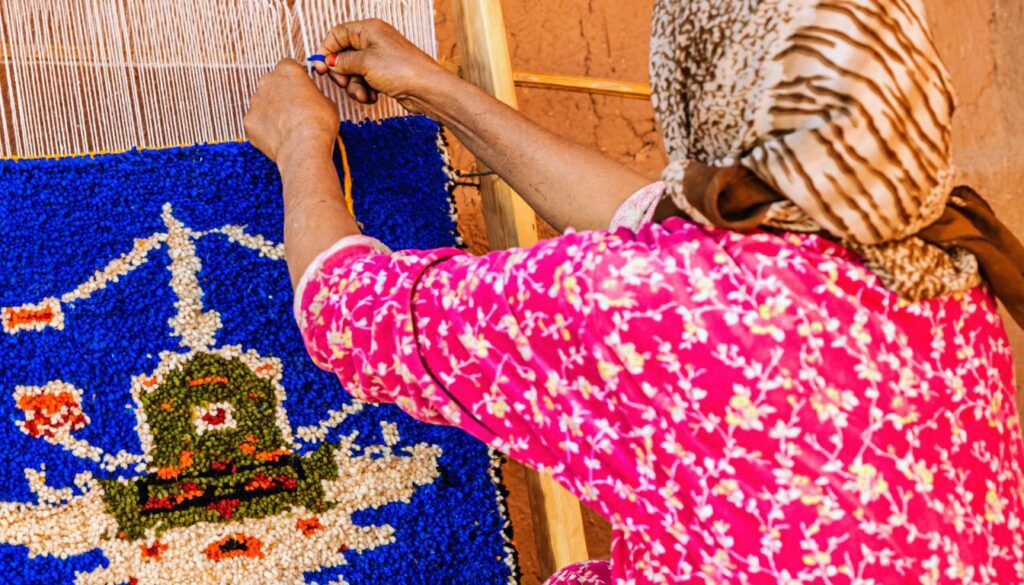Amazigh rugs are beautiful and intricate textiles that have been woven by the indigenous people of North Africa for thousands of years. These rugs are more than just floor coverings; they are a form of artistic expression, a means of storytelling, and a reflection of the rich cultural heritage of the Amazigh people.
Characterized by their bold geometric patterns, vibrant colors, and unique symbols, Amazigh rugs have gained worldwide recognition for their beauty and craftsmanship. Each rug tells a story, with its patterns and motifs often representing aspects of daily life, nature, spirituality, and Amazigh history.
In this article, we will explore the fascinating world of Amazigh rugs, delving into their cultural significance, the meanings behind their symbols, and the skilled craftsmanship that goes into creating these textile masterpieces.
Table of Contents
The Cultural Significance of Amazigh Weaving

Weaving is deeply ingrained in Amazigh culture, playing a crucial role in both daily life and special occasions. The significance of Amazigh weaving extends far beyond mere decoration:
- Cultural identity: Rugs serve as a tangible expression of Amazigh culture and heritage.
- Family tradition: Weaving skills are often passed down from mother to daughter, preserving cultural knowledge.
- Economic importance: Rug making has long been a source of income for many Amazigh families.
- Spiritual and protective functions: Some rugs are believed to ward off evil spirits or bring good luck.
- Storytelling: Rugs often narrate family histories, myths, or important events through their designs.
For the Amazigh people, the act of weaving is a way to connect with their ancestors, express their creativity, and maintain their cultural traditions in a changing world.
Common Symbols and Motifs in Amazigh Rugs
Amazigh rugs are rich in symbolism, with each motif carrying specific meanings. Some common symbols include:
- Diamond shapes: Often represent the evil eye, used for protection.
- Zigzag lines: Can symbolize rivers or snakes, representing water and life.
- Triangles: May represent mountains or represent feminine power.
- X shapes: Often symbolize the human form.
- Lozenges: Can represent fertility or the eye.
Other common motifs include:
- Animals: Such as scorpions, birds, or camels, each with their own significance.
- Plants: Palm trees, flowers, and other vegetation often appear in designs.
- Cosmic symbols: Stars, moons, and suns are frequently incorporated.
These symbols are not just decorative; they form a visual language that conveys messages about the weaver’s life, beliefs, and community.
Materials Used in Traditional Amazigh Rug Making
The materials used in Amazigh rug making reflect the resourcefulness of the weavers and their connection to their environment:
- Wool: The primary material, often sourced from local sheep.
- High Atlas: Known for using wool from sheep raised at high altitudes, prized for its quality.
- Middle Atlas: Often use a mix of sheep and goat wool.
- Cotton: Sometimes used, especially in warps (the vertical threads on a loom).
- Camel hair: Occasionally used, especially in rugs from more arid regions.
- Natural dyes: Traditionally, colors were derived from local plants and minerals:
- Red: Often from madder root or poppies
- Blue: From indigo
- Yellow: From saffron or pomegranate
- Green: Created by overdying blue with yellow
- Synthetic dyes: In more recent times, some weavers have adopted synthetic dyes for a broader color palette.
The choice of materials can often give clues about a rug’s origin and age, with older rugs typically using all-natural materials and dyes.
Weaving Techniques and Tools
Amazigh rug weaving is a complex process that requires skill, patience, and specialized tools:
Techniques:
- Knotted pile: Creates a plush surface, common in colder regions.
- Flatweave: Produces a smooth surface, often used for lighter rugs.
- Mixed technique: Combines both knotted and flatwoven sections.
Tools:
- Loom: Vertical (for pile rugs) or horizontal (for flatweaves).
- Beater: Used to pack down the weft threads.
- Shuttle: Carries the weft thread through the warp.
- Scissors: For trimming the pile and finishing the rug.
The weaving process can take anywhere from a few weeks to several months, depending on the size and complexity of the rug. Weavers often work from memory, with designs passed down through generations or created spontaneously as they work.
Regional Variations in Amazigh Rug Styles
Amazigh rugs vary significantly across different regions, each area having its own distinct style:
- Middle Atlas:
- Often feature diamond shapes and zigzag patterns
- Tend to use bright colors, including reds, oranges, and yellows
- Usually made with a thick pile for warmth
- High Atlas:
- Known for their abstract designs and asymmetrical patterns
- Often use undyed wool, resulting in natural shades of cream, brown, and black
- Typically have a looser weave than Middle Atlas rugs
- Rabat:
- Characterized by intricate floral patterns
- Often feature a central medallion design
- Usually made with finer wool and have a higher knot count
- Taznakht:
- Known for their bold geometric patterns
- Often use a combination of flatweave and pile techniques
- Frequently incorporate symbols like the Amazigh cross
These regional styles reflect local traditions, available materials, and environmental factors, showcasing the diversity within Amazigh weaving culture.
The Role of Women in Amazigh Rug Craftsmanship

Women play a central role in the creation of Amazigh rugs:
- Tradition keepers: Women are often responsible for passing down weaving techniques and design knowledge to younger generations.
- Economic contributors: Rug making allows many women to contribute financially to their families.
- Artistic expression: Weaving provides a means for women to express their creativity and personal stories.
- Social activity: Rug making is often a communal activity, strengthening bonds between women in the community.
The importance of women in rug making reflects their significant role in preserving and promoting Amazigh culture as a whole.
Colors and Their Meanings in Amazigh Rugs
Colors in Amazigh rugs are not chosen randomly but often carry specific meanings:
- Red: Often associated with strength and protection
- Blue: Can represent wisdom or the sky
- Green: Typically symbolizes nature and paradise
- Yellow: Often represents eternity and the sun
- White: Usually represents purity and peace
- Black: Can represent fertility or, in some cases, mourning
The combination and placement of colors in a rug can add layers of meaning to the overall design, creating a complex visual language.
From Tradition to Modern Markets: The Journey of Amazigh Rugs
The appreciation for Amazigh rugs has grown significantly in recent decades:
- Mid-20th century: Western designers and collectors began to recognize the artistic value of these rugs.
- Global market: Amazigh rugs are now sold worldwide, prized for their unique designs and quality craftsmanship.
- Interior design trends: The bold patterns of Amazigh rugs have become popular in contemporary interior design.
- Challenges: Increased demand has led to mass production in some cases, raising concerns about maintaining authenticity and fair compensation for weavers.
This journey from local tradition to global commodity has brought both opportunities and challenges for Amazigh communities.
Caring for and Preserving Amazigh Rugs
Proper care is essential to preserve the beauty and integrity of Amazigh rugs:
- Regular cleaning: Gentle vacuuming and occasional professional cleaning
- Rotation: Regularly rotating the rug helps prevent uneven wear
- Sun exposure: Limiting direct sunlight can prevent fading
- Storage: Proper rolling and storage techniques protect the rug when not in use
- Repairs: Addressing any damage promptly can prevent further deterioration
With proper care, these rugs can last for generations, becoming cherished family heirlooms.
Identifying Authentic Amazigh Rugs
As Amazigh rugs have gained popularity, it’s important to be able to identify authentic pieces:
- Materials: Authentic rugs typically use high-quality, often hand-spun wool
- Imperfections: Hand-woven rugs often have slight irregularities, which can be a sign of authenticity
- Dyes: Traditional rugs often use natural dyes, which may have slight variations in color
- Knot density: This can vary by region, but authentic rugs usually have a consistent knot density
- Age: Older rugs may show signs of wear, which can actually increase their value
Understanding these factors can help buyers appreciate the unique qualities of authentic Amazigh rugs.
The Future of Amazigh Rug Making
The art of Amazigh rug making faces both challenges and opportunities in the modern world:
Challenges:
- Urbanization leading to fewer young people learning traditional techniques
- Competition from mass-produced imitations
- Balancing tradition with market demands
Opportunities:
- Increased global appreciation for handmade, culturally significant textiles
- Efforts to preserve and promote Amazigh cultural heritage
- Innovative approaches combining traditional techniques with contemporary designs
The future of Amazigh rug making will likely depend on finding a balance between preserving traditional methods and adapting to contemporary markets and tastes.
Conclusion
Amazigh rugs represent a vibrant, living tradition that connects the past with the present. These textiles are not just beautiful objects, but carriers of culture, history, and individual expression. Each rug tells a story—of the weaver who created it, the community it came from, and the ancient traditions it represents.
From the intricate symbols that convey messages and beliefs, to the regional styles that reflect local environments and customs, Amazigh rugs offer a fascinating glimpse into the rich cultural tapestry of North Africa. The craftsmanship involved in creating these rugs—from preparing the wool to the final knotting—demonstrates the skill and artistry passed down through generations of Amazigh women.
As these rugs find their way into homes around the world, they bring with them a piece of Amazigh heritage. For those who own or admire these rugs, understanding their background adds depth to their appreciation. It transforms a simple floor covering into a work of art with layers of meaning and cultural significance.
The future of Amazigh rug making stands at an interesting crossroads between tradition and modernity. As efforts continue to preserve this craft and promote fair trade practices, there’s hope that this beautiful art form will continue to thrive, adapting to new contexts while maintaining its core cultural essence.
In appreciating Amazigh rugs, we not only admire their aesthetic beauty but also honor the rich cultural heritage they represent. These textiles serve as a reminder of the enduring power of traditional craftsmanship and the universal human desire to create beauty and meaning through art.
Discover the must-visit cultural destinations of Amazigh culture













